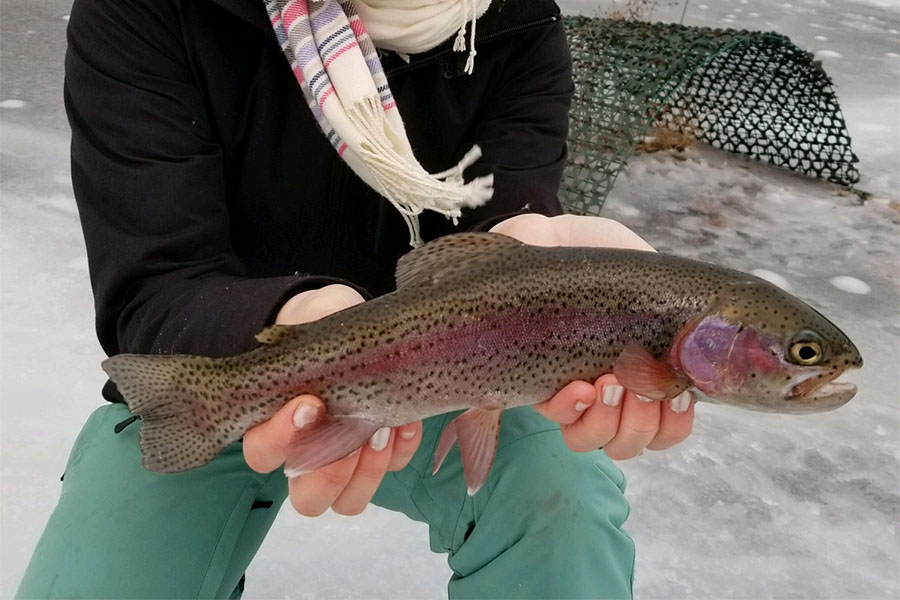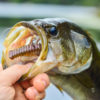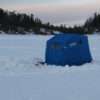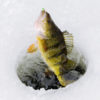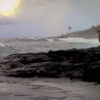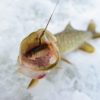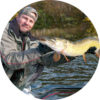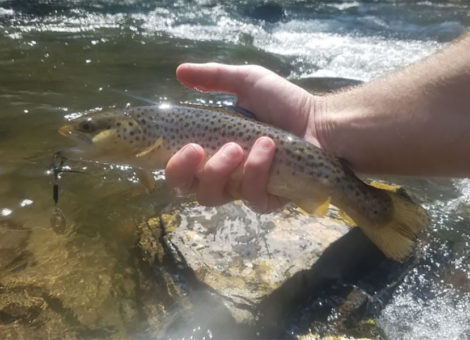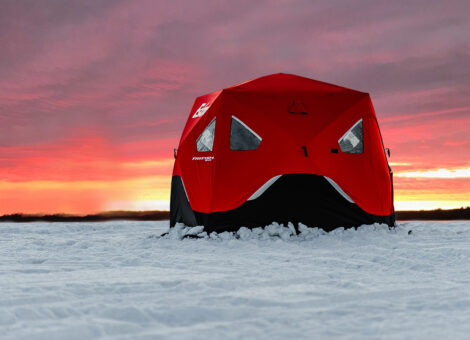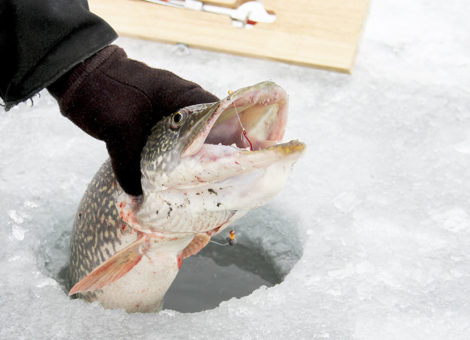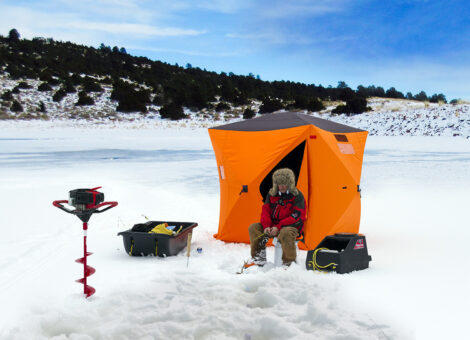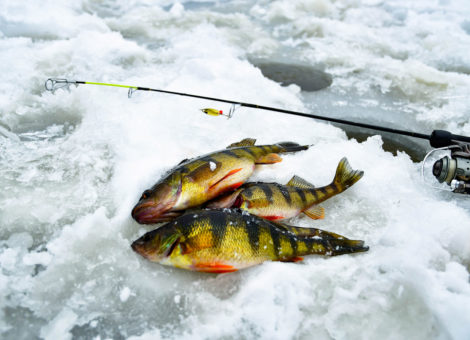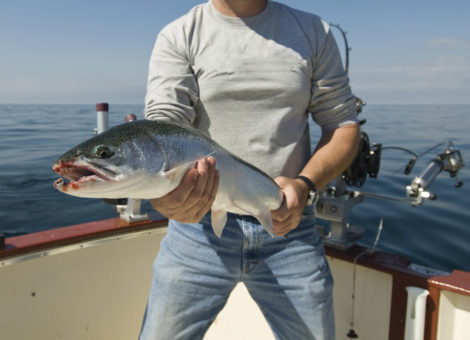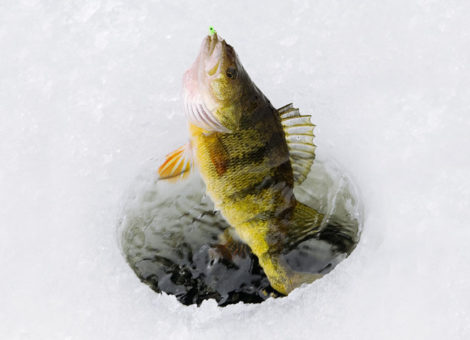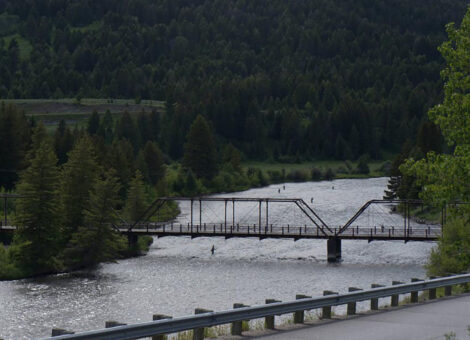Trout are one of the most popular sport fish among angler’s. They are fast, delicious, and aggressive feeders year around regardless of water conditions. They are also a favorite species for fish hatcheries to stock into lakes, ponds, and reservoirs across the country during the fall and early spring months. Because trout stay active even in cold conditions, ice-fishing has become a popular method to catch these fish when lakes, rivers, and streams freeze in the winter. With this guide, I hope to give you a breakdown of the tips and tricks to catch these incredible fish under the ice.
Trout Species
Multiple species of Trout can be found in the waters of the U.S. Brown trout, Rainbow trout, Brook trout, and Cutthroat Trout are all commonly caught in the northern lakes and streams of the U.S. Each species has its own quirks and habits that the angler can exploit to target them. For this article, I will focus primarily on Rainbow trout, the most commonly stocked species across the U.S., and what many people are familiar with as a Trout.
Fun fact: Steelhead are actually Rainbow trout that have been bred and farm-raised
- When and Where to Go Ice Fishing for Trout
- Best Time of Year to Ice Fish for Trout
- What is the Best Time of Day to Ice fish for Trout?
- What is the Best Depth to Ice Fish for Trout?
- States and Popular Lakes for Trout Fishing on the Ice
- Best Spots to Ice Fish for Trout
- Essential Ice Fishing Tackle and Equipment for Trout
- Best Baits and Lure for Trout Ice Fishing
- Methods for Trout Ice Fishing
- Tips and Tricks for Trout Ice Fishing
When and Where to Go Ice Fishing
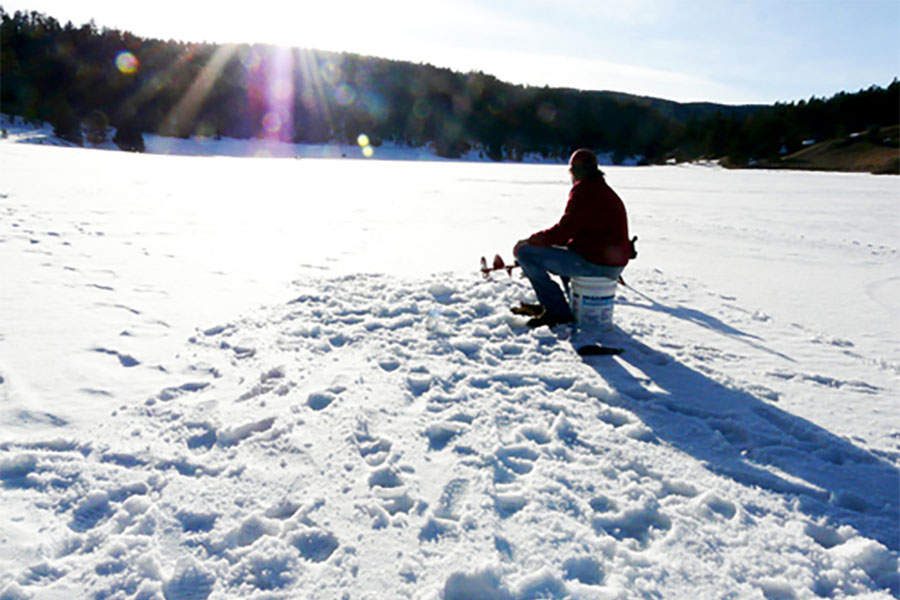
Best Time of Year to Ice Fish for Trout
Although Trout thrive in colder water, water colder than 45 degrees Fahrenheit will cause them to become sluggish as their metabolism begins to slow down. Early and late winter, when the ice is still thick enough to stand on, are ideal times to target Trout as they are most likely still at their most active during the winter months.
What is the best time of day to ice fish for trout?
Trout are extremely sensitive to water temperatures below the ice. The water below the ice is subject to changes in temperature just as it is above. Because Trout become sluggish in colder water, and because they need light to see their prey, it’s best to target them during the sunniest, warmest part of the day when ice fishing. You can target them in the morning and evening. Because trout need light to see their prey, ice fishing for trout at night is less productive than ice fishing for trout during the day. However, Rainbow Trout are the less crepuscular of the trout species compared to their cousin, the Brown Trout. (Crepuscular: Predatory fish that feed during the morning and evening.)
What is the best depth to ice fish for trout?
Unlike other freshwater game fish species, trout thrive in cold water. Where many fish species migrate to deeper waters as water temperatures plummet, many trout species, such as rainbows, actually move to shallower waters. Trout can be found as shallow as 4 to 6 feet during the dead of winter, with 4 to 10 feet a common depth for trout fishing. Lake trout will be found in deeper water 20 to 60 feet during winter.
States and Popular Lakes for Trout Fishing on the Ice
Trout are often stocked throughout the country during the fall months in lakes, rivers, and ponds that cannot sustain Trout during the hotter summer months of the year. Check with your local fisheries department to learn if they have a rainbow trout stocking program to ice-fish over the winter. There are plenty of waterways in the U.S. that hold trout year around as well. The great lakes have trout year around and freeze over enough for them to be caught, thanks to generous stocking programs.
- Wisconsin – Black Oak Lake, Big Green Lake, Beaver Dam Lake, Geneva Lake, Lake Michigan
- Minnesota – Lake of Woods, Gull Lake, Snowbank Lake, Lake Saganaga, South Lake, North Lake, Mayhew-Birch-Moss Lake, Big Trout Lake, Grindstone Lake, Caribou Lake, Pit Lake (Find a complete list of Minnesota trout ice fishing lakes at the Minnesota Department of Natural Resources Trout fishing streams & lakes list.)
- Michigan – Crystal Lake, Keweenaw Bay, Higgins Lake, Bear Lake, Maceday Lake, Burt Lake, Blue Lake, Saginaw Bay, Pere Marquette Lake
- Ohio – Wallace Lake, Lake Erie
- New York – Indian Lake, Lake Champlain, Fourth Lake, (Visit New York State Dep. of Environmental Conservation for a complete list of New York ice fishing lakes with trout.)
- North Dakota – North Lemmon Lake, Northgate Dam, Fish Creek Dam, Harmon Lake, Nygren Dam, Moon Lake, Devils Lake, McGregor Dam (find more ND trout fishing lakes at North Dakota Game and Fish.)
- South Dakota – Sheridan Lake, Deerfield Reservoir, Center Lake, Leigion Lake, Stockade Lake, Pactola Lake, Sylvan Lake, Black Hills (800 miles of trout fishing streams and 38 reservoirs. Visit the Black Hills of South Dakota Fishing Guide.)
- Maryland – Lake Habeeb, Deep Creek Lake
- Michigan – Copper Harbor, Higgins Lake, Lake Michigan, Center Lake, Walloon Lake, Lake Charlevoix, Burt Lake, Elk Lake, Torch Lake (View all Michigan trout fishing lakes.)
- California – Castle Lake, Silver Lake, Boca Lake, Caples Lake, Donner Lake, Frenchman Lake, Gold Lake, Prosser Reservoir, Red Lake, Stampede Reservoir, Lake Sabrina, Mammoth Lakes
- Colorado – Lake Granby, Antero Reservoir, Chambers Lake, Eleven Mile Reservoir, Harvey Gap Reservoir, Trinidad Lake State Park, Chatfield Reservoir, Crawford Reservoir, Twin Lakes Reservoir, Blue Mesa Reservoir, Taylor Reservoir, Needle Creek Reservoir, Dome Lakes
- Wyoming – Boysen Reservoir, Brooks Lake, Sulfur Creek Reservoir, Seminoe Reservoir, Trout Lake, Alcova Lake, Big Sandy Lake, Flaming Gorge Reservoir, Fontenelle Reservoir, Fremont Lake, Pathfinder Reservoir, Pilot Butte Reservoir, Trout Lake
- Maine – Moosehead Lake, Lake Wassookeag, Allagash Lake, East Grand Lake, Sebago Lake, Eagle Lake, Portage Lake, Cobbosseecontee Lake, Great East Lake, Long Lake, Square Pond, Trickey Pond
- Idaho – Fernan Lake, Cocolalla Lake, Upper Twin Lake, Lower Twin Lake, Winchester Lake, Spring Valley Reservoir, Elk Creek Reservoir, Lake Cascade, Horsethief Reservoir, Mann Creek Reservoir, Salmon Falls Creek Reservoir, Little Wood Reservoir, Devil Creek Reservoir, Daniels Reservoir, Chesterfield Reservoir, Jim Smith Lake, Williams Lake, Henrys Lake
- Montana – McGregor Lake, Whitefish Lake, Swan Lake, Murray Lake, Loon Lake, Foy Lake, Cad Lake, Rogers Lake, Vinal Lake, Canyon Ferry Lake, Clark Canyon Reservoir, Deadmans Basin Reservoir, Flathead Lake, Fort Peck Lake, Georgetown Lake, Hauser Lake, Holter Reservoir, Lake Frances, Whitefish Lake, Willow Creek Reservoir
- Utah – Strawberry Reservoir, Scofield Reservoir, Hyrum Reservoir, Mantua Reservoir, Flaming Gorge Reservoir, East Canyon Reservoir, Deer Creek Reservoir, Rockport Reservoir, Fish Lake, Jordanelle Reservoir, Pineview Reservoir, Bear Lake
Lakes in higher elevations in Montana, North Dakota, and Idaho offer some of the best ice-fishing for trout during the year’s colder months.
Best Spots to Ice Fish for Trout
Trout remain active throughout the year, even when ice covers the surface. Their diet primarily consist of insect larvae, minnows, and crawfish during the winter. When targeting trout, fish in an area where you believe these food sources will be plentiful. Deeper cuts in the lake or along the shoreline are prime for hunting zones for small baitfish and insect larvae. Rocky bottoms are excellent habitats for crawfish and other bottom dwellers trying to keep a low profile. Fish these areas for best results.
- Points and Drop-offs – Larger Trout can be found on top of or near the lake bottom where there are changes in depth. These changes in depth are typically found on drop-offs and off the sides of points. A topographic map of the lakebed will help you locate these transitional zones.
- Structure – As with many predatory species, structure is always a good starting point for targeting trout on a lake or river. Fallen logs, giant boulders, sunken boats, or docks all provide excellent habitat for trout looking for a safe place to rest. Unfortunately, underwater structure is challenging to find on a frozen lake; therefore, some fall scouting or local knowledge can go a long way.
- Depth – Rainbow trout are highly susceptible to changes in water temperature and dissolved oxygen concentrations. Under the ice, there is minimal change in water temperature. However, hot sunny days cause the water near the shoreline to rise substantially due to the ice reflecting light onto the rocks. It’s best to maintain a 10 ft depth or greater where this warming effect doesn’t affect the trout’s natural habits. Later in the winter, you might consider fishing deeper if your honey hole is no longer producing. The fish might have gotten too cold and moved to deeper, warmer water.
Essential Ice Fishing Tackle and Equipment for Trout
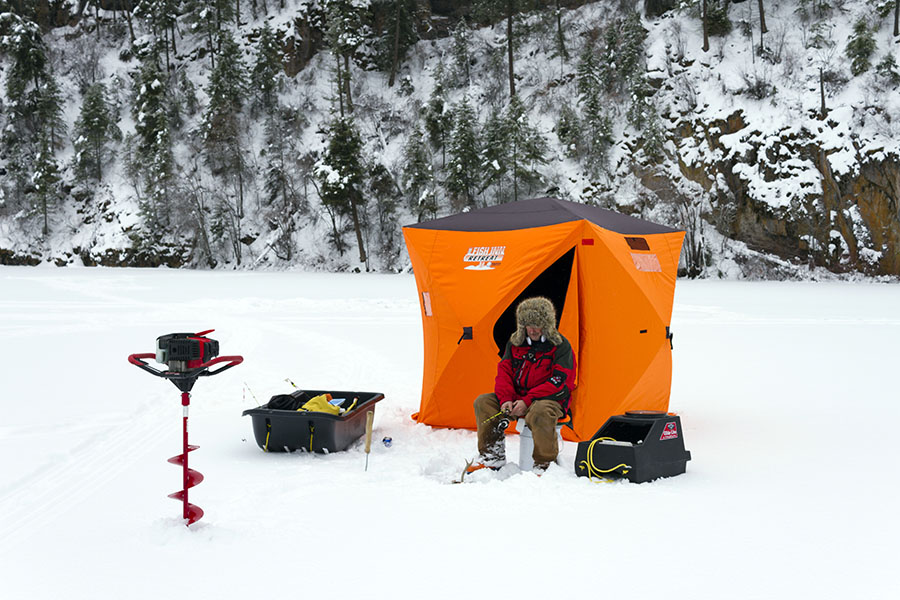
Many species of trout can grow to gigantic proportions. Rainbow trout can grow to up to 40 inches in length! This means that you will want tackle that can handle a larger fish. Light ice-fishing tackle is acceptable for the beginning angler to use, but if you want to take it up a step, try to use larger tackle than what you would use for perch or bluegill.
I also recommend investing in higher quality tackle. Having good tackle and equipment will ensure you have a positive, more productive ice fishing experience. You want to spend your time fishing, not dealing with problematic or broken equipment.
Ice Fishing Tackle
You’re main ice fishing gear include a rod, reel and line.
- Reel – 2000 to 3000 size spinning reels are ideal for trout fishing of all sizes. It never hurts to have a little beefier reel for that extra line capacity and drag if you are in an area such as the great lakes, where much larger specimens can be found.
If you’re ice fishing for lake trout you may want to have a fish reel with high line capacity. A large, fiesty lake trout may take out a lot of line. A high capacity fishing reel typically isn’t necessary for rainbows or brown trout.
- Rod – For trout fishing through the ice, any size standar ice fishing pole is perfectly fine to use. Keep your rod between 3-4ft light to medium action. A smaller the trout species you’re targeting the lighter the action required. A medium action rod is ideal for large browns and rainbow trout. A medium or medium-heavy action is recommended when targeting lake trout under the ice.
- Line – Because Trout have good vision and an eye for anything out of place, keeping your line light will drastically improve your chances of inducing a bite. To put it into perspective, I was outfished 3:1 by my brother using 2.5 pound test fluorocarbon while I was using 6 pound test fluorocarbon in the same hole. If you are concerned with your line breaking, don’t be. Remember, the fish is nearly weightless in the water.
For most trout species including brown and rainbow trout, a 4 to 6-pound test monofilament line with a 6 to 10-ound mono or fluoro leader is ideal for ice fishing. For larger trout species such as lake trout that live in deeper waters, a heavier 10 to 15-pound test braided line and a 6-8 pound flourocarbon leader is recommended. The braided line is ideal for fishing deeper water because it does not stretch like monofilament and flourocarbon lines.
Equipment for any Ice Fishing Excursion
In addition to rod, reel and line, the following items are also helpful.
- Ice Drill/borer (auger) – an electric borer will improve your willingness to drill more holes
- Depth finder/Transducer – Knowing your depth is crucial when scouting for fish
- Buckets – What fisherman goes fishing without a bucket?
- Chairs – Sitting on hard ice with your bare bum is not fun
- Shovel – To scoop the ice out of your boring hole
- Some snacks and a hot drink never hurt as well
- A tent with a small heater will ultimately improve your quality of life on the ice
- Rod holders – Try the JawJacker if you want to get some automatic hooksets
- Ice Puck or Cover – There are quite a few gadgets available that will keep your hole in a state of entropy that won’t allow it to freeze.
- Rod Bells – will help you notice fish bites even in low light conditions
Best Baits and Lures for Trout Ice Fishing
Both natural and artificial baits can be used to ice fish for trout. Trout are a coldwater fish species that actively feed all winter. They will readily take a variety of baits and lures.
Best Natural Baits to Use for Trout
Trout are active predators even in the coldest months of the year. Live baits such as minnows and crawfish work great. However, logistically it’s much easier to use night crawlers or waxworms on colder days when keeping bait alive becomes an issue.
- Salmon eggs or Skein – This bait is fantastic for trout. The salmon eggs are bright, smelly, and a favorite amongst trout regardless of whether there are salmon around or not. Artificial salmon eggs also work well if you can find them in your local tackle shop.
- Minnows – On bright sunny days, live minnows work great for active trout and other game fish. The flash and vibration that the minnow puts into the water column attract fish from far away. Minnows should be rigged a #5-#7 hook depending on the size of fish you’re targeting. When fishing for lake trout, slightly larger minnows and hooks are required.
- Waxworms and Nightcrawlers – Relatively passive live baits typically require the angler to have at least one jigging rod to bring fish closer to the baits themselves.
Best Artificial Ice Fishing Lures for Trout
When using artificial lures for trout under the ice, remember that a lot of flash goes a long way. I typically try to pick the flashiest lures I can find unless I know I’m in an area where many fish will be swimming by my baits.
- Jigs between 1/64 to 1/8-ounces tipped with wax worms or small minnows is a preferred treat for hungry rainbows during cold winter months. If you’re targeting larger lake trout, then tube jigs tend to work well. A heavier jig may be required when fishing deeper waters or in rough conditions.
- Marabou Jigs are as simple as they get and have always been an effective way to pull fish off of structure or deep from the bottom. Try to use various colors throughout the day, changing to darker colors the brighter the sun.
- Flutter Spoons are tried and true favorite amongst all ice fishermen, the flutter spoon throws a lot of flashes and has a small enough profile not to spook wary fish.
- Vertical Jigging Spoons that are shinny or in the shape of a minnow are an effective lure when ice fishing for trout. You can try different weights and sizes to see which produces a bite.
- Spinners are a consistently reliable lure to fish for trout under the ice. The spinner puts out plenty of flash and vibration to bring the Trout to your lure or baits.
Methods for Trout Ice Fishing
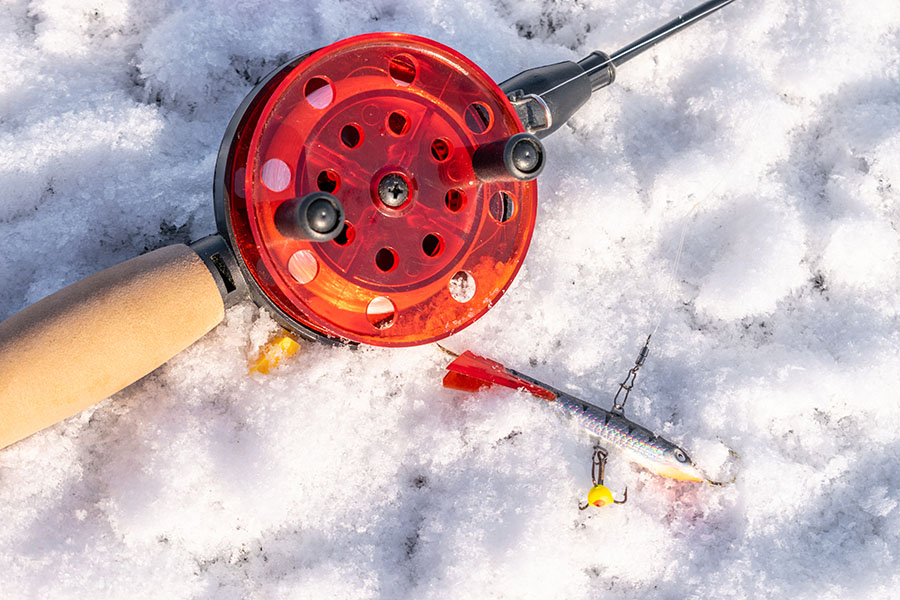
To begin your ice fishing adventure for Trout, you will want to deploy two methods: Active jigging and Dead-sticking. Trout like to move a wide area and typically don’t congregate in schools larger than 2-3 in the dead of winter. This makes consistently targeting trout a challenge in frozen lakes and rivers. For efficiencies sake, bring at least two dead-stick rods with rod holders and one active jigging rod. The purpose of all this tackle will be made clear below.
- Dead-Sticking – This method of trout fishing on the ice is ubiquitous amongst ice fishers worldwide. It involves setting a baited fishing line on a rod and then walking away. Set at least two dead sticks in holes a few feet apart.
- Active Jigging – Because Trout are wanderers, we must bring the fish to our tackle. This is where jigging comes into play. While jigging for Trout, your goal is to attract them from a long distance away. Expect about 20% of your hits from active jigging, while most bites will come off your dead sticks.
- Tip Ups – When targeting large trout species such as lake trout, tip ups are an effective fishing method. Tips will work on other trout species, but lake trout are typically large enough to trip the flag.
Tips and Tricks for Trout Ice Fishing
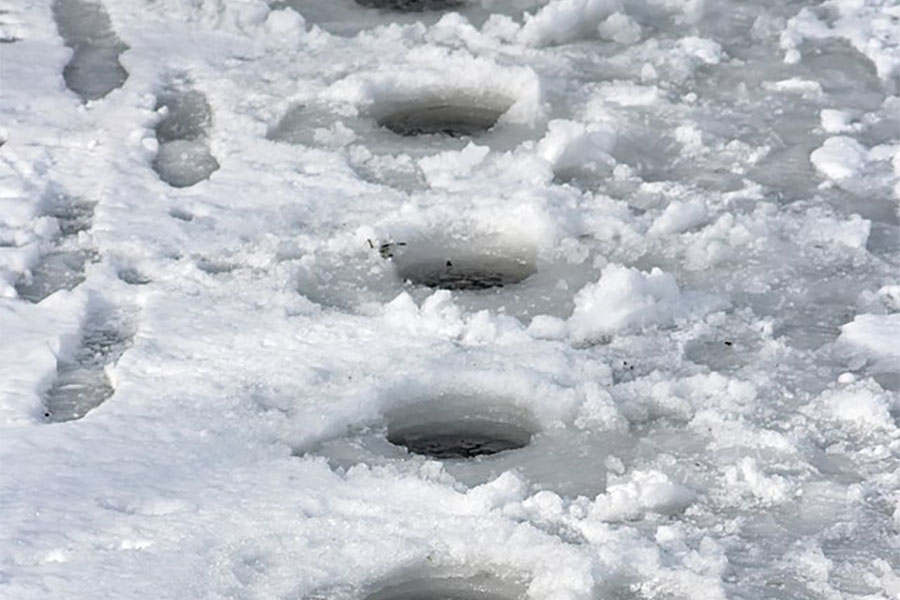
Proven tips and tricks for catching trout under the ice.
- Tip 1. Add some scent to your artificial lure. Trout have incredible vision and a powerful sense of smell. Use this to your advantage by tipping your hooks with a minnow head or salmon egg.
- Tip 2. Drill your holes close together but keep them separate. While jigging your artificial lure, you also attract curious fish closer to your baits. Therefore it’s crucial to keep your dead-stick holes near your jigging hole. This way, if the Trout isn’t interested in your artificial lure, it might be more interested in one of your tasty live baits floating just underneath it.
- Tip 3. Keep your baits off the bottom. A common mistake people make when ice fishing for Trout is letting the bait get to the bottom. Typically keeping whatever bait or lure you are using suspended in the water column will be much more effective at getting a fish to notice.
- Tip 4. Best harvest size. Trout are delicious regardless of size; however, filleting smaller fish often isn’t the best option. Typically fish under 12inches, I’ll remove the guts and cook them whole on the grill or stove. That single 12-inch fish cooked whole is enough of a meal for an entire person instead of needing much more fish for the fillets.
Go Catch’em
Catching Trout through the ice is a fun and rewarding pastime that can provide hours of entertainment for the whole family. Although the bite may be a little slower than other species of fish, the outcomes are worth the wait. Trout put up a great fight through the ice and can grow to genuinely great sizes in some environments. Remember that this guide is primarily for catching Rainbow Trout in the areas mentioned. Lake Trout are much deeper, Brown Trout are more aggressive, and Brook Trout typically like shallow moving water. If you follow some of the tricks and methods I’ve outlined above, I’m sure you will succeed in all your ice-fishing endeavors.


